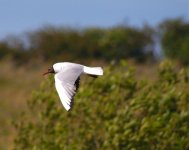If you just want "Great shot!", don't read the rest of my post - Flickr is better than here for that

But if you really want critique that might help you to get better results...
Firstly, if you want any useful critique, you'll need to provide EXIF data, as it's been stripped from the image. So Shutter Speed, Aperture, ISO, Camera make/model, Lens, how much cropping was done, distance to subject, conditions, etc. The more info you give, the more detailed a critique you get back
All I can say without any of the above details is;
- It looks like you've overexposed the whites, but that can be very difficult to get right in bright sunlight. If your camera has a small sensor (P&S Superzoom) the Dynamic Range is limited, meaning it can be impossible to get much detail in some whites (same applies to blacks)
- Most shots of a moving subject look better with space for the subject to move/fly into... so crop or frame the shot with more space in front of the bird than behind (same applies to a static subject, but with the space where it's facing).
- The image also looks noisy, but that could be due to distance, atmospheric conditions, high ISO, or limits of the equipment used.
- There is some blurring that may be caused by the shutter speed or by panning but not keeping up with the bird. There's nothing wrong with blurred wings, but generally the head needs to be sharp - so either a fast shutter speed, or pan the camera with the bird... or both
But... any image of a bird in flight is a success, no matter what equipment is used. Hopefully others will reply with other opinions... especially if you post the EXIF data and shooting conditions etc.






